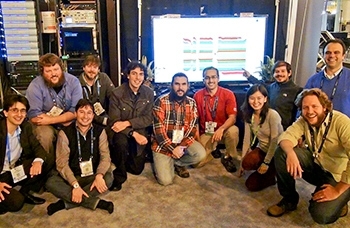

Researchers transferred 1,400 gigabits per second at event to advance the transmission of LHC data (photo: Antoninho Perri/Unicamp)
Researchers transferred 1,400 gigabits per second at event to advance the transmission of LHC data.
Researchers transferred 1,400 gigabits per second at event to advance the transmission of LHC data.

Researchers transferred 1,400 gigabits per second at event to advance the transmission of LHC data (photo: Antoninho Perri/Unicamp)
Agência FAPESP – A network of researchers in which Brazil plays an important part set a new record for data distribution at Supercomputing 2014 (SC14), a conference for high-performance computing, networking, storage and analysis. The conference, in its 26th year, was held in New Orleans, USA, on November 16-20.
The team achieved a data transfer rate of 1,400 gigabits (1.4 terabits) per second. At the previous meeting of the conference, the highest rate was just over 750 gigabits.
“It should be stressed that we’re talking about a sustained data rate, which we were able to keep stable, and not the peak data rate, which in our case reached 1.5 terabits per second,” said team member Alaelson Jatobá, a PhD student at the University of Campinas (Unicamp).
According to another team member, Darli Mello, an assistant professor at the Communications Department of Unicamp’s School of Electrical & Computer Engineering (FEEC), business enterprises and research institutions attend the conference to present the latest advances in supercomputing as well as data transfer and processing.
“The event has been attended for some years by the international high-energy physics community, which is involved in complex experiments on the fundamental properties of matter, performed using giant particle accelerators. Each experiment generates enormous datasets, which are processed and interpreted by scientists in different parts of the world,” Mello said in a statement on Unicamp’s website.
The best-known particle physics experiment is the Large Hadron Collider (LHC), built by CERN, the European Organization for Nuclear Research. The collider is on the border between France and Switzerland.
Caltech (the California Institute of Technology) leads an international network of high-energy physicists that has supported CERN’s program for 20 years. Researchers at the University of Michigan and Vanderbilt University in the United States and at the University of Victoria in Canada are also members of the network that set the new record at SC14.
Brazil’s participation consists of researchers from Unicamp, São Paulo State University (UNESP), the National Teaching & Research Network (RNP), Rio de Janeiro State University (UERJ), Padtec, and the Academic Network at São Paulo (ANSP), which is funded by FAPESP.
The team used the concept of software-defined networking (SDN), which includes a centralized intelligence for the coordination of the various network elements by means of software.
“Analysis of the data generated by the LHC is highly complex and requires an equally complex and advanced communications network. This part of the networking technology is coordinated by Professor Harvey Newman at Caltech. Brazil’s strong presence in this high-energy physics network is coordinated by Professor Sergio Novaes at UNESP,” Mello said, referring to the project supported by FAPESP.
The experiment used equipment supplied by Padtec, a manufacturer of optical transmission and networking systems based in Campinas. Several of the firm’s professionals are graduates of Unicamp and continue to work intensively with FEEC’s researchers.
“Since 2012, Padtec has supplied the optical infrastructure, or network backbone, for this demonstration. Working at FEEC in collaboration with UNESP and Caltech, we developed a tool to integrate the firm’s equipment with the SDN controller,” Mello said.
Padtec’s contribution to the conference included state-of-the-art optical computers and transponders. A transponder is a transmitter-responder—a wireless communications, monitoring or control device that picks up and automatically responds to an incoming signal.
Dalton Soares Arantes and Max Henrique Machado Costa, professors at Unicamp who run its Digital Communications Laboratory (ComLab) as well as collaborative projects with Padtec, said the firm has considerable expertise in high-speed optical networks.
Arantes explained, “One of the bottlenecks in supercomputing today is the difficulty of building a feasible distribution network that links multiprocessors around the world for people to work at high speeds.”
Some of Padtec’s research projects that have recently been supported by FAPESP include “Coherent optical technologies” and “Digital processing for electronic compensation in optical communications systems,” led by Arantes.
A list of all the researchers in the network and more information about the Supercomputing Conference can be found at http://supercomputing.caltech.edu/team.html.
Republish
The Agency FAPESP licenses news via Creative Commons (CC-BY-NC-ND) so that they can be republished free of charge and in a simple way by other digital or printed vehicles. Agência FAPESP must be credited as the source of the content being republished and the name of the reporter (if any) must be attributed. Using the HMTL button below allows compliance with these rules, detailed in Digital Republishing Policy FAPESP.




